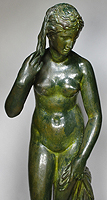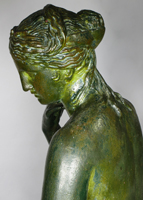
Description:
A Fine Pair of Neoclassical Greco Roman Style 19th Century Cast-Iron Figures of "The Berlin Adorante" Modeled as a nude young man standing with arms outstretched and a nude Venus Goddess, her hair braided and with her right hand raised to her hair, next to an urn draped with her robe, after the antique model of "The Capitoline Venus" (also known as "The Bather"), both in a green patina. Circa: 1860-1870.
Height of male: 55 1/4 inches (140 cm)
Overall width: 17 1/2 inches (44.5 cm)
Overall depth: 21 1/2 inches (54.6 cm)
Height of Venus: 53 inches (135 cm)
Overall width: 15 1/2 inches (39.4 cm)
Overall depth: 14 inches (35.6 cm)
Ref.: A2012
"Berlin Adorante" refers to the celebrated bronze sculpture of the ancient world which was once owned by King Charles I and acquired in 1747 by Frederick II of Prussia for the Sanssouci Palace in Potsdam. The original sculpture is currently part of the collection of the Alte Museum, Antikensammlung, Berlin, inv. No. Sk 2.
Many scholars believe that it originates from the Hellenistic Period (circa 300 B.C.) in Greece, rather than a Roman copy.
The Capitoline Venus is a type of statue of Venus, specifically one of several Venus Pudica (modest Venus) types (others include the Venus de' Medici type), of which several examples exist. The type ultimately derives from the Aphrodite of Cnidus. The Capitoline Venus and her variants are recognisable from the position of the arms—standing after a bath, Venus begins to cover her breasts with her right hand, and her groin with her left hand.
The original of this type (from which the following copies derive) is thought to be a lost 3rd- or 2nd-century BCE variation on Praxiteles' work from Asia Minor, which modifies the Praxitelean tradition by a carnal and voluptuous treatment of the subject and the goddess's modest gesture with both hands—rather than only one over the groin, in Praxiteles's original.
ABOUT CAST IRON SCULPTURES
Cast-iron had been in production during the 18th century but its inferior status to the more fashionable and delicate wrought-iron had generally confined its use to architectural work. By the early 19th century, however, rapid developments of the Industrial Revolution combined with the simultaneous burgeoning of a new middle class provided the impetus for a dramatic expansion in its application and in a short space of time a proliferation of iron foundries across Europe and America thrived on the production of everything from inkstands to railway stations. The use of cast-iron for garden ornament became particularly widespread at this time, as the possibilities for its mass-production at a fraction of the cost of bronze made it the material of choice for indoor/outdoor statuary, figural lighting, fountains and vases.
The strengths of Roman sculpture are in portraiture, where they were less concerned with the ideal than the Greeks or Ancient Egyptians, and produced many very characterful works, and in narrative relief scenes. Examples of Roman sculpture are abundantly preserved, in total contrast to Roman painting, which was very widely practiced but has almost all been lost. Latin and some Greek authors, particularly Pliny the Elder in Book 34 of his Natural History, describe statues, and a few of these descriptions match extant works. While a great deal of Roman sculpture survives more or less intact, it is often damaged or fragmentary.
Early Roman art was influenced by the art of Greece and that of the neighbouring Etruscans, themselves greatly influenced by their Greek trading partners. An Etruscan speciality was near life size tomb effigies in terracotta, usually lying on top of a sarcophagus lid propped up on one elbow in the pose of a diner in that period. As the expanding Roman Republic began to conquer Greek territory, at first in Southern Italy and then the entire Hellenistic world except for the Parthian far east, official and patrician sculpture became largely an extension of the Hellenistic style, from which specifically Roman elements are hard to disentangle, especially as so much Greek sculpture survives only in copies of the Roman period. By the 2nd century BCE, "most of the sculptors working at Rome" were Greek, often enslaved in conquests such as that of Corinth (146 BCE), and sculptors continued to be mostly Greeks, often slaves, whose names are very rarely recorded. Vast numbers of Greek statues were imported to Rome, whether as booty or the result of extortion or commerce, and temples were often decorated with re-used Greek works.
A native Italian style can be seen in the tomb monuments of prosperous middle-class Romans, which very often featured portrait busts, and portraiture is arguably the main strength of Roman sculpture. There are no survivals from the tradition of masks of ancestors that were worn in processions at the funerals of the great families and otherwise displayed in the home, but many of the busts that survive must represent ancestral figures, perhaps from the large family tombs like the Tomb of the Scipios or the later mausolea outside the city. The famous bronze head supposedly of Lucius Junius Brutus is very variously dated, but taken as a very rare survival of Italic style under the Republic, in the preferred medium of bronze. Similarly stern and forceful heads are seen in the coins of the consuls, and in the Imperial period coins as well as busts sent around the Empire to be placed in the basilicas of provincial cities were the main visual form of imperial propaganda; even Londinium had a near-colossal statue of Nero, though far smaller than the 30 metre high Colossus of Nero in Rome, now lost. The Tomb of Eurysaces the Baker, a successful freedman (c. 50-20 BC) has a frieze that is an unusually large example of the "plebeian" style.
The Romans did not generally attempt to compete with free-standing Greek works of heroic exploits from history or mythology, but from early on produced historical works in relief, culminating in the great Roman triumphal columns with continuous narrative reliefs winding around them, of which those commemorating Trajan (CE 113) and Marcus Aurelius (by 193) survive in Rome, where the Ara Pacis ("Altar of Peace", 13 BCE) represents the official Greco-Roman style at its most classical and refined. Among other major examples are the earlier re-used reliefs on the Arch of Constantine and the base of the Column of Antoninus Pius (161), Campana reliefs were cheaper pottery versions of marble reliefs and the taste for relief was from the imperial period expanded to the sarcophagus.
All forms of luxury small sculpture continued to be patronized, and quality could be extremely high, as in the silver Warren Cup, glass Lycurgus Cup, and large cameos like the Gemma Augustea, Gonzaga Cameo and the "Great Cameo of France". For a much wider section of the population, moulded relief decoration of pottery vessels and small figurines were produced in great quantity and often considerable quality.
After moving through a late 2nd century "baroque" phase, in the 3rd century, Roman art largely abandoned, or simply became unable to produce, sculpture in the classical tradition, a change whose causes remain much discussed. Even the most important imperial monuments now showed stumpy, large-eyed figures in a harsh frontal style, in simple compositions emphasizing power at the expense of grace. The contrast is famously illustrated in the Arch of Constantine of 315 in Rome, which combines sections in the new style with roundels in the earlier full Greco-Roman style taken from elsewhere, and the Four Tetrarchs (c. 305) from the new capital of Constantinople, now in Venice. Ernst Kitzinger found in both monuments the same "stubby proportions, angular movements, an ordering of parts through symmetry and repetition and a rendering of features and drapery folds through incisions rather than modelling... The hallmark of the style wherever it appears consists of an emphatic hardness, heaviness and angularity — in short, an almost complete rejection of the classical tradition".
This revolution in style shortly preceded the period in which Christianity was adopted by the Roman state and the great majority of the people, leading to the end of large religious sculpture, with large statues now only used for emperors, as in the famous fragments of a colossal acrolithic statue of Constantine, and the 4th or 5th century Colossus of Barletta. However rich Christians continued to commission reliefs for sarcophagi, as in the Sarcophagus of Junius Bassus, and very small sculpture, especially in ivory, was continued by Christians, building on the style of the consular diptych.
Source: Wikipedia











